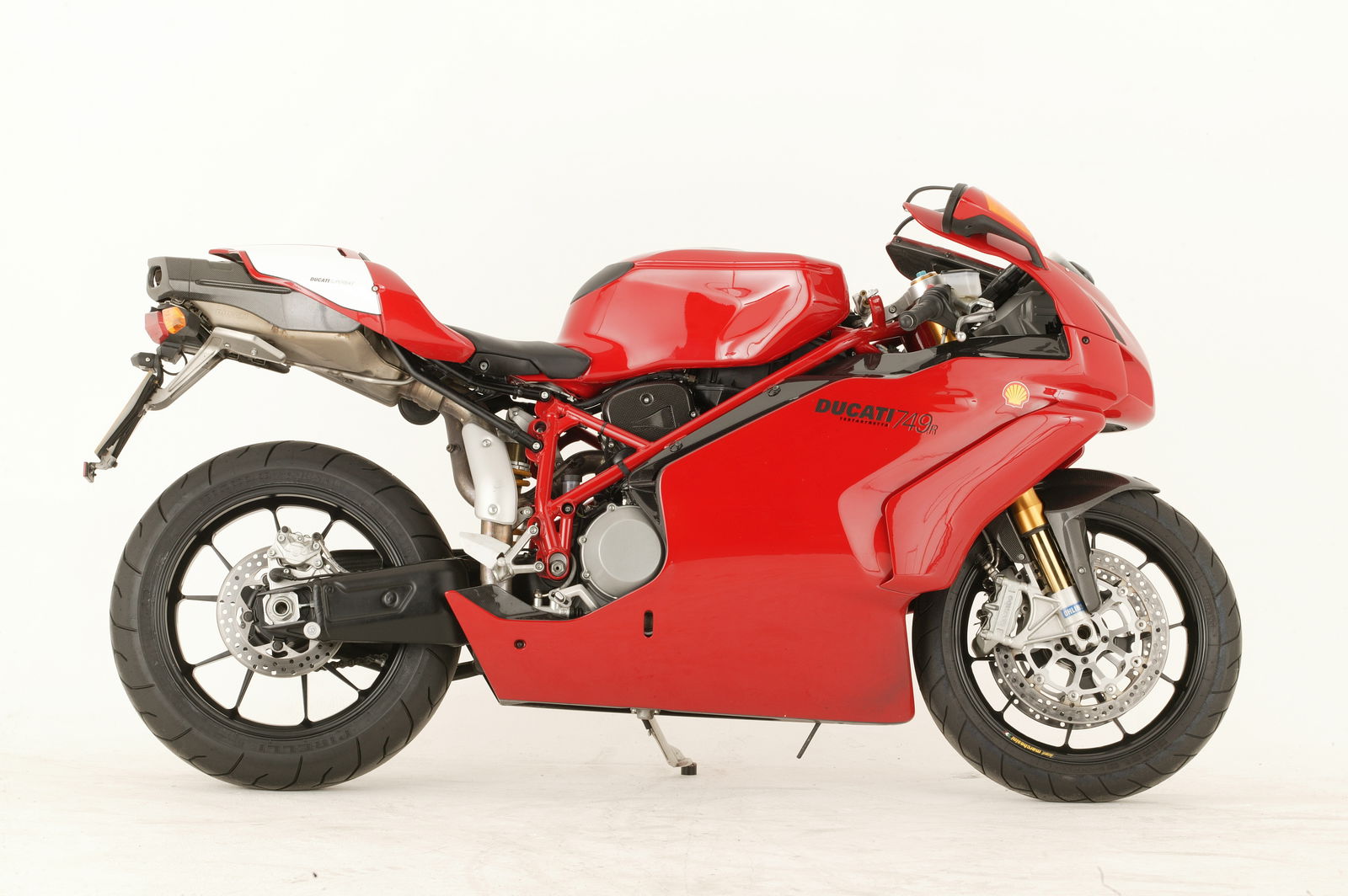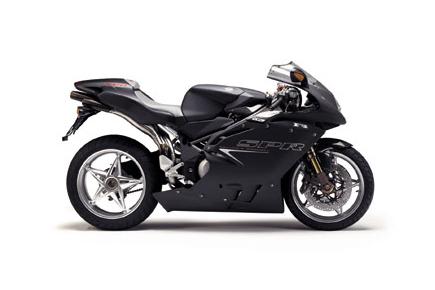2004 Fireblade CBR1000RR review
The 2004 Fireblade CBR1000RR is a brilliantly balanced package with a smooth, powerful motor that isn’t intimidating to use, all wrapped up in a superb chassis.

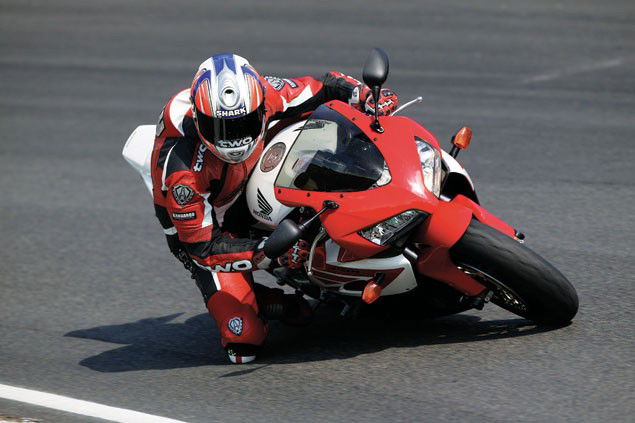
The 2004 Fireblade CBR1000RR feels very similar to its predecessor when it comes to riding position, despite the fact that Honda has moved the pegs slightly up and back and the bars slightly down. Which came as a bit of a surprise to me. Because of the new styling I kind of assumed that like the CBR600RR the new ‘Blade would be tiny, but it isn’t.
For a six-footer like myself it doesn’t feel cramped, although the pegs are a touch high. It keeps the real world riding position of the previous model, which was a big selling point for the majority of ‘Blade owners who used their bike for more than just the occasional weekend blast. It doesn’t have the perched-on-the-top-yoke 600RR feel, but it’s slightly more aggressive than the old ‘Blade with your weight slightly more forward.
Corner properly and the new Fireblade is every bit as good and planted as the CBR600RR, which is saying something indeed.
Through the tight chicanes in the track the ‘Blade went from knee-down right to knee-down left bloody quickly and with half the usual effort that it usually requires, but it’s mid-corner the bike really impresses.
Get the Honda over and it just feels like you could keep on leaning it forever and if it ever decides to let go it will have the common decency to let you know first, probably by post. Honestly, the chassis really is that good you have that much warning time. There were quite a few corners on the track where cars had broken up the surface and even with the ‘Blade right on its ear the bumps still couldn’t unsettle its composure.
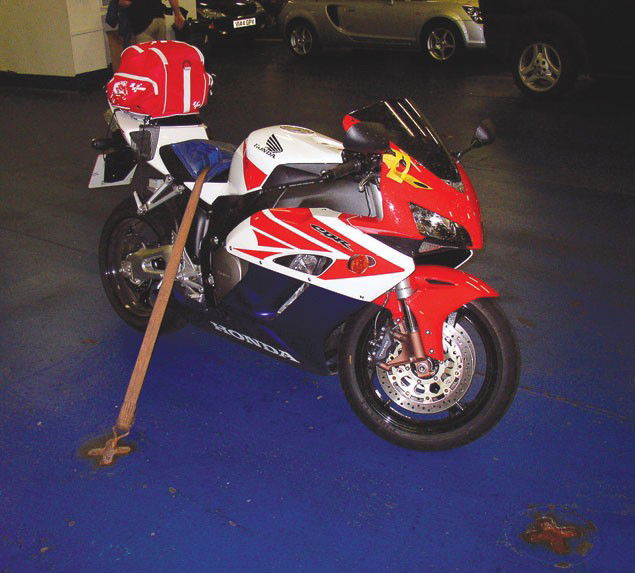
But as well as being so composed mid-corner the new chassis also allows you to use the new 998cc motor with confidence. Looking at the stats I thought the new ‘Blade would be a wheelie monster, but it isn’t really. Yes, it will wheelie with encouragement but the chassis is designed to allow the rider to put the power down with both wheels remaining on the road. Where the old bike would wheelie as you exited corners, the new one won’t.
Second gear corners and hard acceleration are usually a decent recipe for a highside, but the Fireblade doesn’t have the feeling it’s going to do this. Open the throttle hard exiting a corner and the thing just drives forward. Fast.
Despite the claims of 172bhp this is at the crank, so take off around ten per cent for a rear wheel figure and you’re left at a genuine 145bhp. Which isn’t exactly weedy. But the ‘Blade doesn’t feel like a 145bhp bike, well not in the intimidating way.
The power builds up really smoothly to the 12,250rpm redline with no real kicks or power bands. Where the GSX-R has several distinct jumps in power the ‘Blade just keeps on building. This can take some of the harsh and exciting edge off it but when you’re trying to drive out of a corner with the bike still leant over I much prefer the feeling of a constant build up of power than a sudden change in delivery. But it can be a bit deceptive. Because the power builds up gently it is very easy to get carried away and find yourself arriving at corners far faster than you actually think you’re going.
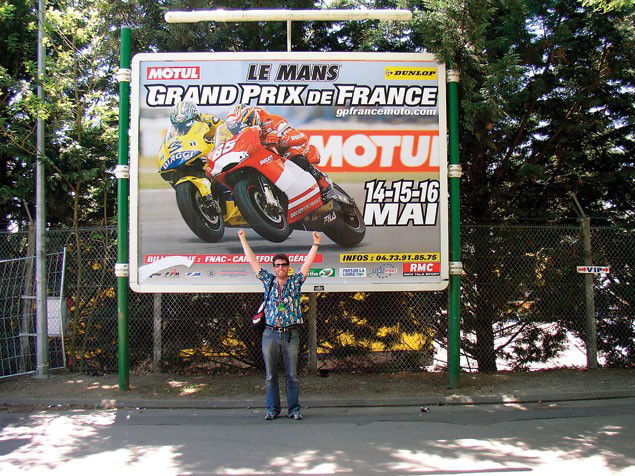
Which is probably why Honda has made the brakes so strong. The new radial calipers on the 2004 ‘Blade are excellent. Two fingers is all you need no matter what speed you’re going at and the power and feeling is brilliant, once you get used to them. Initially they almost feel like overkill, which is what I thought after the first session, but once you recalibrate your head to how good they are this feeling goes. I did find that the rear tended to go a bit light under hard braking on standard suspension settings, but this is cured by increasing the preload and rebound stiffness on the forks.
Having spent a morning riding the bike I suddenly remembered the new electronic steering damper. Does it work? Well, I suppose so because I forgot it was there.
I struggle to find any faults with the Fireblade. It is just my kind of bike – a 600 on steroids. It turns quickly, handles fantastically, has a beautifully smooth engine, brilliant brakes and above all is comfortable. The fuel injection is still a bit snatchy going from a closed throttle to open but really this is about the only fault, although personally I don’t like the colour schemes as I think they make the bike look duller than it is.
The new Blade doesn’t quite give you the adrenaline kick the GSX-R does because the engine’s so smooth to use, but I reckon most riders won’t consider this a problem and will be able to explore the potential of the chassis both on the road and track with greater confidence.
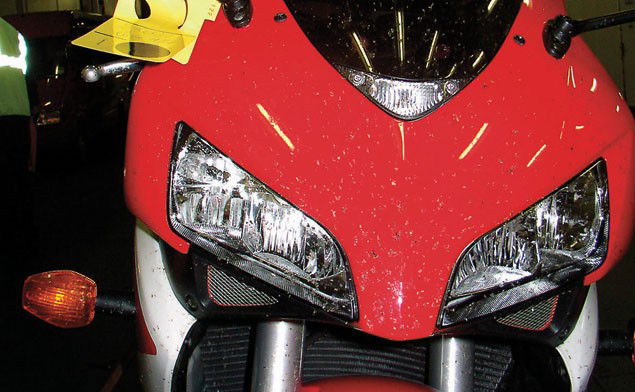
2004 Fireblade CBR1000RR specs
| Length (mm) | 2025 |
| Width (mm) | 720 |
| Height (mm) | 1120 |
| Dryweight (kg) | 176 |
| Seats | 1 |
| Seat Height (mm) | 820 |
| Suspension Front | 43mm inverted H.M.A.S. cartridge-type telescopic fork, 120mm axle travel |
| Suspension Rear | Unit Pro-Link with gas-charged H.M.A.S. damper, 135mm axle travel |
| Adjustability Front | Stepless preload, compression and rebound |
| Adjustability Rear | Stepless preload, compression and rebound |
| Wheels Front | 17M/C x MT3.50 |
| Wheels Rear | 17M/C x MT6.00 |
| Wheels Made Of | Hollow-section triple-spoke cast aluminium |
| Tyres Front | 120/70 ZR17M/C (58W) |
| Tyres Rear | 190/50 ZR17M/C (73W) |
| Brakes Front | 310 x 5mm dual hydraulic disc with 4-piston callipers |
| Brakes Rear | 220 x 5mm hydraulic disc with single-piston calliper |
| Tank Capacity (litres) | 18 |
| Wheelbase (mm) | 1410 |
| Ground Clearance (mm) | 130 |
| Rake (degrees) | 23 |
| Trail (mm) | 102 |
| Chassis | Diamond; aluminium composite twin-spar |
| Colours | Pearl Fadeless White (with Winning Red and Matte Barents Blue Metallic), Black (with Moonstone Silver Metallic), Winning Red (with Matte Gun Powder Black Metallic) |
| Cubic Capacity (cc) | 998 |
| Valves | 16 |
| Max Power (bhp) | 170 |
| Max Power Peak (rpm) | 11250 |
| Torque (ft/lb) | 85 |
| Torque Peak (rpm) | 8500 |
| Bore (mm) | 75 |
| Stroke (mm) | 56.5 |
| Valve Gear | DOHC |
| Compression Ratio | 11.9 |
| Ignition | Computer-controlled electronic |
| Valves Per Cylinder | 4 |
| Cooling | Liquid-cooled |
| Fuel Delivery | PGM-DSFI electronic fuel injection |
| Stroke Type | Four Stroke |
| Drive | Chain |
| Top Speed | 177.1 |
| Standing Quarter Mile - Terminal Speed MPH | 140.21 |
| Standing Quarter Mile - Time | 10.81 |
| Test Fuel Consumption - Average | 37.46 |
| Test Fuel Consumption - Best | 40.52 |
| Test Fuel Consumption - Worst | 36.06 |
| Max Power | 153.8 |
| Max Power Revs | 11100 |
| Max Torque | 79.5 |
| Max Torque Revs | 8384 |
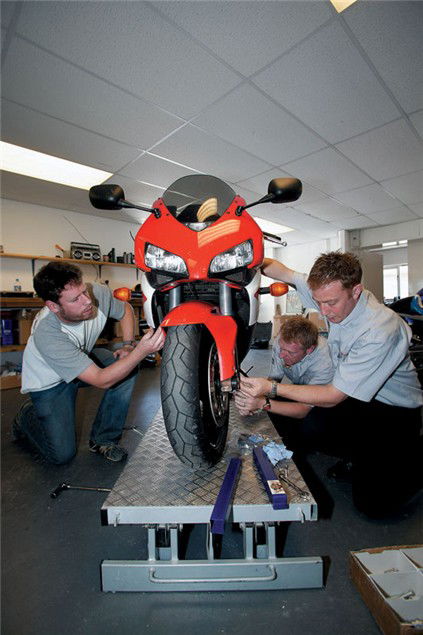
Living with a 2004 Honda Fireblade CBR1000RR
Words by Jon Urry
August 2004
Urry takes the Blade for a romantic weekend in Le Mans before a rough thrashing at Oulton Park
Running a bike in. What's it all about then? Well if you read the feature somewhere about the process it will, I'm sure, explain all the various reasons why you should take it easy for the first X-hundred miles , but personally I reckon it's more to do with getting riders used to a new bike before they go banzai - especially one as powerful as the blade.
It's common knowledge that if you thrashed old Blades from the off, they blossomed earlier and the motor made more power initially.
Run them in correctly and the power generally reached a peak point at around 10,000 miles, thrash them from the off and you are talking nearer 4000 miles. So I was faced with a bit of a dilemma when I picked up the bike with just 20 miles on it: to thrash or not to thrash, that is the question.
According to the Honda guy, I was to take it easy for the first 300 miles and keep it below 6000rpm before gently increasing the revs as the miles pick up to 600 when it was due its first service. After that, anything is fair game.
Fair enough I reckoned; I could be restrained for that long, but that was still 600 miles taking it easy. I needed a plan, something to help relieve the boredom and cover miles fast. Chatting to some of the ads guys in the office, I knew they were planning a trip to the Le Mans MotoGP, leaving the day after I picked up the blade. Le Mans and back added up to 700 miles - perfect.
Despite it being late notice, a quick call to travel firm Page & Moy and I was sorted. For £279, they supplied me with Dover/Calais ferry tickets and a room at a hotel in Le Mans for three nights, which works out at about £40 more than doing it yourself, but considering the number of people expected to arrive for the GP, it's worth it for avoiding having to scour the town to find a room.
The next day, the blade had a tailpack with a big lock, a few shirts and pants, waterproofs and a toothbrush in it strapped to the pillion pad and we were off on our first big adventure together.
With my usual level of organisation I left the office a bit late, but the blade managed the first leg of 90 miles of motorway to Dover in bang on an hour and all without going over 6500rpm. Maybe running it in wouldn't be so bad after all...
As we all stuck in a group for the trip down to Le Mans, the blade wasn't really too stressed following Jim on his SV650 and managed an impressive 130 miles before the fuel light came on. I found it really comfortable on the dual carriageways at a steady 90mph (despite the racy riding position) and even my long legs didn't feel the onset of cramp until near the time the tank needed filling up again.
In fact, the main problem I encountered on the whole journey down was that the blade is just getting into its stride and the power is just starting to come in at 6500rpm. This makes cruising at just below the 100mph mark tricky as the bike wants to accelerate and only a slight movement of the throttle is enough to get the speedo showing into three figures. This sounds like a small point but it could be crucial when speeds above 100mph mean a ban in the UK, so I like to keep the speedo showing 90-something on motorways.
We abandoned the bikes once we got to Le Mans and chained them together to ward off any thieving scum, before making our way to the circuit on foot, which proved the best option as the French police were busy pulling over any bike with a loud can. The campsite at the circuit, which doubled up as the car park, resembled Beirut on a bad day. And while I'm on the subject; what is it about the French that simply revving an engine gives them so much pleasure?
Racing over and despite the blade's temperature gauge reaching - and holding at - 104° Fahrenheit for nearly an hour as we fought our way through the traffic away from the circuit, the blade didn't seem unduly bothered. With the odo showing over 300 miles, I 'gradually increased the revs' on the way home until the speedo showed 179mph. The Honda managed to average 110 miles between fuel stops, despite doing around 120mph all the way home.
Back home and after a first service of an oil and filter change, it was off to Oulton Park and the road around for a feature on FireBlades that will be in next month's issue. Honda BSB rider Michael Rutter joined us on the road and reckoned my road bike felt like his racer. Although he did take the piss out of the hero blobs, asking what they were for, before telling us he grinds the fairing out on his bike, flash twat.
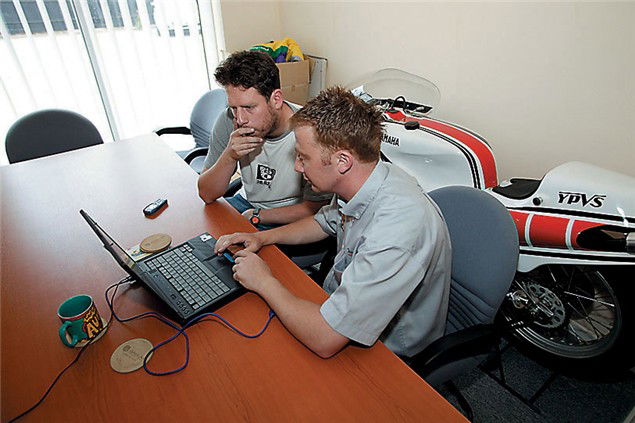
October 2004
You're nothing these days without your own telemetry. Honda's flagship sports tool gets treated to a spot of clever electrickery
Like any relationship, the Fireblade and myself are now settling down after the initial excitement of the chase. But I have to confess I took a fiery Latino lady home the other night - Ducati's 749R. But she was too much like hard work and I was soon looking forward to the home comforts of the Honda.
Our relationship needed a kick, so I treated the old girl to a colour matched pillion seat cover and a tinted screen. Both are genuine Honda accessories, available from your local dealer.
The seat cover is a definite improvement in terms of looks and the lack of pillion pad isn't a problem as I hate taking people on the back anyway. Next on the list of improvements were some R&G Racing crash protectors . Being the paranoid sort I opted to fit as many as possible. The paddock stand nubbins and fork protectors fitted without any hassle in about 10 minutes, but the fairing protectors required drilling holes in the fairing. The whole job took about an hour.
Being a bit of a geek, I like things like data logging, dyno curves and all that. But the problem with most data logging kits is they cost an arm and a leg. Then Cougar Racing offered to fit a data logging kit to the Blade. Their kit consists of sensors for rpm, front and rear suspension, throttle position, water temperature, speed, voltage and G-force, and even a gear change light. Add a wiring loom, 32MB data card, software and free fitting, and at £880 it doesn't seem too bad value at all.
Dropping the Blade off at Cougar's base next to Stansted Airport, I was reassured by their professionalism and by the simply gorgeous 500cc Yamaha two-stroke V-four GP bike on the bench next to the Blade. Cougar used to race in GPs under the Sabre Sports banner, and this bike was the one WCM's Chris Burns highsided at Donington last year.
The kit took around three hours to fit, mainly because they had never been near a new Blade before, and apart from the two suspension sensors and an errant wire, you'd hardly know it's there.
I'm still getting to grips with the software, but if you want to have a go log onto www.sabresport.co.uk, download the free programme and have a play. There's also a forum for confused people to get help from slightly less confused people.
I now intend to get the Blade out on track and use the data logger to amuse my fellow riders with the pathetic amount of throttle opening I use.
Finally, I should mention the stunning performance of the Pirelli Diablo Corsa tyres. The Corsa is the softer of the Diablo compounds but it still lasted an amazing 4000 miles on the rear before needing changing, with the front fine for another 2000 or so miles. This includes a day at Oulton Park but, to be fair, it's mainly commuting through traffic and a few long distance motorway trips. All the same, 150bhp on tap and a tyre lasting 4000 miles is very impressive - I'll be interested to see if the Bridgestone BT014s can match this.
Here's the crazy story of what ended up happening to Urry's stolen Fireblade.
